|
The "Last" Stochastic Technique |
The Stochastic oscillator is a momentum or price velocity indicator developed by George Lane. The calculation is very simple:
![]()
Where:
K = Lane's Stochastic
C = latest closing price
L = then-period low price
H = the n-period high price
Additionally, Lane's methods specifically required that the K be smoothed twice with three-period simple moving averages. Two other calculations are then made:
SK = three period simple moving average of K
SD = three period simple moving average of SK
The classic interpretation of a stochastic can be complicated. The basic method is to buy when the SK is above the SD, and sell when the SK moves below the SD. However, the stochastic employs a fixed period-to-period calculation that can move about erratically as the earliest data point is dropped for the next day's calculation. Due to this instability and false signals generated, using a stochastic for entry and exit signals can incur a lot of unprofitable trades. To compensate for this inherent weakness, buy signals are generally reinforced when the crossover occurs in the 10-15% ranges, and sells in the 85-90% range.
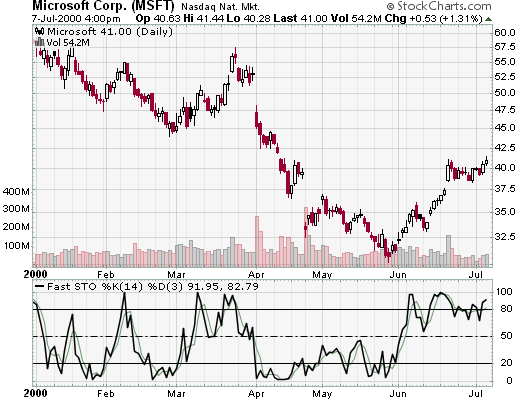
Unfortunately, many techniques for using the stochastic oscillator can produce consistent losses over time. Some analysts have recommended smoothing the data further, or looking for a confirming overbought/oversold ratio prior to selling or buying. Most secondary filters such as overbought/oversold indicators degrade the performance of the stochastic in that one does not take advantage of major trends, getting whipsawed in and out.
K39 - The Last Stochastic Technique
A study published in "The Encyclopedia of Technical Market Indicators" found
that some very good signals were given by an unsmoothed 39 period stochastic
oscillator (K = 39, no signal line). A buy signal is generated when K crosses
above 50% and the closing price is above the previous week's high close. Sell
and/or sell short signals are created when the K line crosses below 50% and the
closing price is below the previous week's low close. Taking a longer period,
and not smoothing the data over a 3-period moving average allows the analyst to
view Lane's Stochastic.
Note: You can add the Last Stochastic to our SharpChart charting tool by adding the "Slow Stochastic" indicator with parameters of 39 and 1. Here is an example. Alternately, you can choose "Scott McCormick's Fund Settings" from the "Custom Settings" dropdown.
In the chart below for MSFT, we see that the 39 period K crossed above 50% on June 14, at around $36.00.
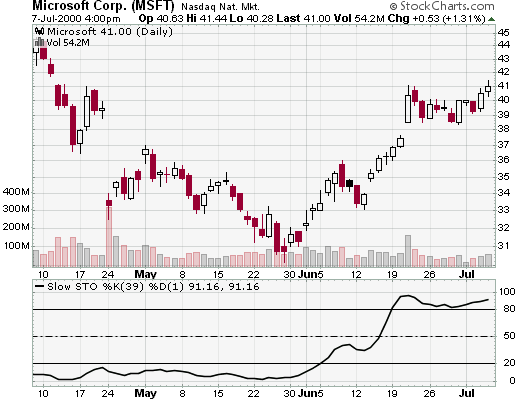
Weekly, Daily and Hourly through Minute data can all be used effectively for the 39 period stochastic. Using weekly data for three years, we see that the 39-Week Stochastic for MSFT didn't cross below 50% until late February, 2000.
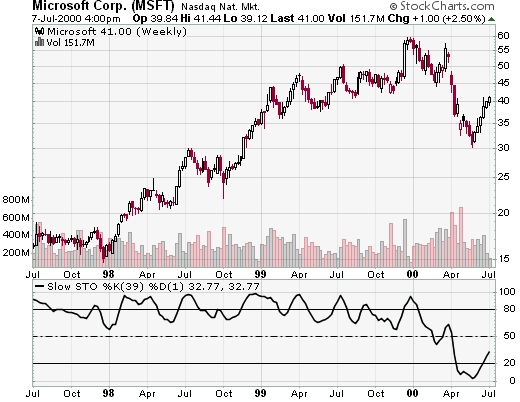
The whipsaw that occured for MSFT the following month shows the need for signal confirmation. If we look at CSCO for the last year on daily data, we see that by the 39 day stochastic, it was a hold from November 1999 at $17 through early April 2000 at $32 a share. Here again, we see a false rally at the end of April. What can be used for confirmation?
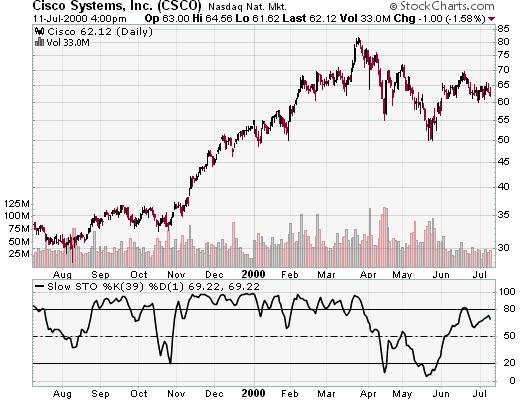
Confirmation
Since the Stochastic is a price momentum indicator, one should pair it with a
volume assessment for trade confirmation. In the chart below, the
On
Balance Volume (OBV) indicator has been added along with a 30 day MA as a
signal line.
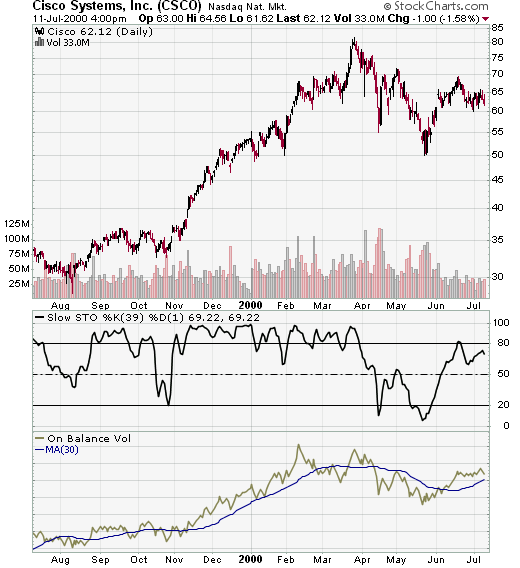
Current version of this chart.
Notice that there was a bullish OBV crossover in early November 1999 and again in early June 2000 soon after the K line moved back above 50%. Although the Last Stochastic reversed in April, the OBV crossover did not occur. When the K line moved above 50% again in early June, confirmation soon followed.
One last point to remember is that all stocks are unique, and while the 39 period Stochastic is a useful technical indicator, one should always map the performance against your specific stock. Recently, most Tech stocks have evidenced a tendency to signal entry at a K crossover above 40% and a sell with K crossing below 60%. However, in volatile equities a second price or sentiment indicator along with a volume indicator provides the best confirmation.